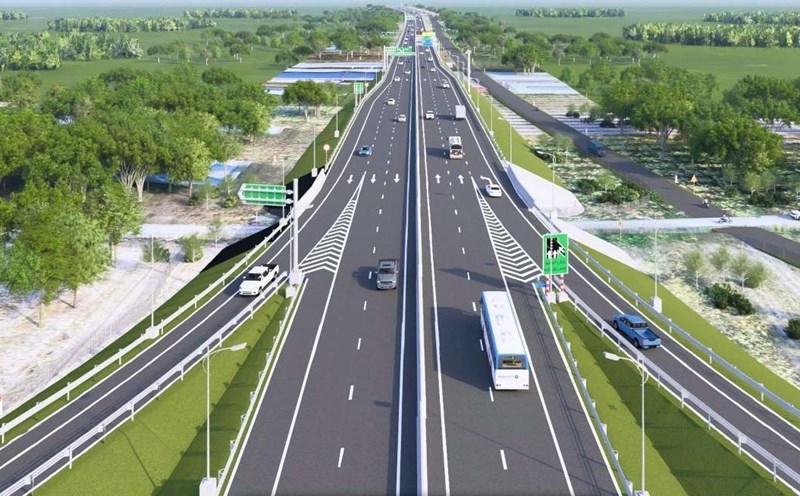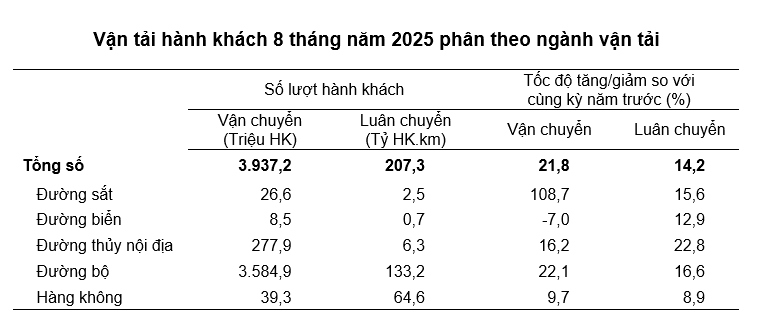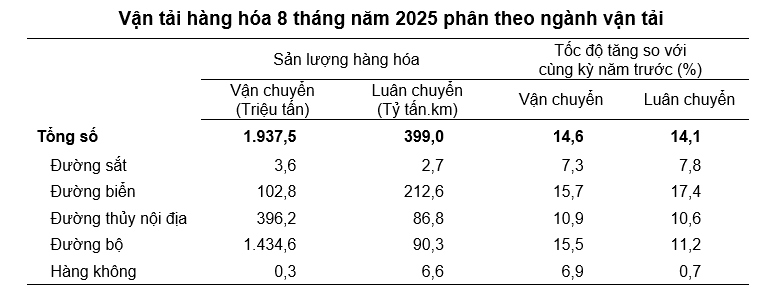
Illustration+
The peak travel season, coinciding with the 80th National Day holiday, has driven an upswing in transportation during August. According to the August economic and social situation report from the General Statistics Office (Ministry of Finance), in the first eight months, passenger transport increased by 21.8% and freight transport rose by 14.6% compared to the same period in 2024.
PASSENGER TRANSPORT GROWS THANKS TO TOURISM
In August 2025, passenger transport volume was estimated at 542.6 million trips, up 2.2% from July; passenger traffic turnover reached 27.8 billion passenger-kilometers, also up 2.2%.
Compared to August 2024, the increases were 25.1% and 19.2% respectively. Cumulatively, in the first eight months, total passenger transport volume reached 3,937.2 million trips, up 21.8% year-on-year; passenger traffic turnover reached 207.3 billion passenger-kilometers, up 14.2%.
Notably, domestic transport still dominated with more than 3,924 million passengers, up 21.8%. International passenger transport was estimated at 13.1 million, up 9.6%, contributing 41.8 billion passenger-kilometers, up 9.2%. The expansion of the international travel market has become a new factor boosting air transport.
By mode of transport, road remained the key player, carrying more than 3.58 billion passengers in the first eight months, up 22.1% year-on-year; passenger traffic turnover reached 133.2 billion passenger-kilometers, up 16.6%.

Statistics on passenger transport structure in the first eight months of 2025. Source: General Statistics Office
Air transport stood out as a key player in interregional and international passenger transport. In the first eight months, the aviation sector served 39.3 million passengers, up 9.7%, with passenger traffic turnover of 64.6 billion passenger-kilometers, up 8.9%. Notably, international visitors to Vietnam reached nearly 13.9 million, up 21.7%, with 85.2% arriving by air.
Railways attracted attention with a growth rate of 108.7%, reaching 26.6 million passengers. This increase largely came from the addition of data from Hanoi and Ho Chi Minh City metro lines. Nevertheless, the growth also reflects an inevitable trend: Vietnam’s urban areas are shifting strongly toward mass public transport, helping ease pressure on road systems.
In contrast, maritime transport carried only 8.5 million passengers, down 7% year-on-year, though passenger traffic turnover increased by 12.9%. This indicates that passenger sea transport has not yet been fully exploited despite Vietnam’s 3,200 km coastline and hundreds of tourist islands. Meanwhile, inland waterway transport recorded strong growth, carrying 277.9 million passengers (up 16.2%) and achieving 6.3 billion passenger-kilometers (up 22.8%).
FREIGHT TRANSPORT MAINTAINS GROWTH
Along with passengers, freight transport in August also saw stable growth. According to the General Statistics Office, freight volume reached 254.8 million tons, up 1.3% compared to July; freight traffic turnover reached 53.8 billion ton-kilometers, up 1.1%. Compared to the same period in 2024, freight transport volume increased by 15.7% and turnover by 17.7%. Cumulatively, in the first eight months, total freight volume reached 1,937.5 million tons (up 14.6%); turnover was 399.0 billion ton-kilometers (up 14.1%).
Of this, domestic freight transport reached 1,904.1 million tons (up 14.7%), while international freight transport accounted for 33.4 million tons (up 8.5%), but contributed significantly to turnover with 169.4 billion ton-kilometers (up 22.9%).

Statistics on freight transport structure in the first eight months of 2025. Source: General Statistics Office
By transport mode, road accounted for the largest freight volume with 1,434.6 million tons (up 15.5%), but turnover reached only 90.3 billion ton-kilometers (up 11.2%), showing that most goods were transported over short distances.
Maritime transport carried 102.8 million tons (up 15.7%) but generated 212.6 billion ton-kilometers, accounting for more than 53% of the industry, reaffirming its key role in import-export activities.
Inland waterway transport reached 396.2 million tons (up 10.9%) and 86.8 billion ton-kilometers (up 10.6%), making an important contribution to the transport of bulk goods and agricultural products.
Rail transport carried only 3.6 million tons (up 7.3%), while air freight reached 0.3 million tons (up 6.9%), mainly high-value, urgent goods.
A major challenge is that Vietnam’s logistics costs remain high. According to the World Bank, logistics costs account for about 16.8% of GDP, higher than Thailand’s 12% and Malaysia’s 11%. This factor reduces the competitiveness of Vietnamese goods in international markets. Many exporters still face high transport costs due to underdeveloped infrastructure, limited connectivity between seaports – inland ports – industrial zones, as well as congestion on key transport routes.
In the context of increasingly complex global trade, logistics is no longer just a supporting tool but has become a decisive factor for national competitiveness. Without prompt improvement in infrastructure, stronger development of multimodal transport, and optimization of logistics chains, Vietnam’s freight growth could be constrained in the coming years.